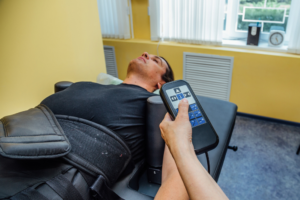
Chiropractors are medical professionals who specialize in caring for the musculoskeletal and nervous systems. People with back and neck injuries, sports injuries, and uninjured people trying to feel their best can all benefit from chiropractic care. The American Medical Association recommends chiropractic care as a first-line treatment for back pain. Studies have shown that people who receive chiropractic care soon after an injury are less likely to end up dealing with chronic pain or relying on addictive pain medications.
Chiropractic care focuses on aligning the spine so that the nerves that branch through the vertebrae can function correctly. Adjustments can treat conditions caused by poor neurological function, like chronic earaches in kids, some breathing problems, poor sleep, and anxiety.
Chiropractic care isn’t all about “getting cracked” here are three types of care your chiropractor can provide.

1. Spinal Adjustment
Spinal adjustment is the mainstay of chiropractic care. It’s typically performed manually, meaning the chiropractor uses his hands, sometimes with assistance from special tables or handheld tools. Chiropractors are trained in dozens of methods for adjusting the spine, pelvis, and other joints. Sometimes an adjustment will cause a cracking sound from gas leaving the joint. This may sound alarming, but it’s not painful.
While some types of adjustments use thrusting motions to move misaligned vertebrae into place, others use gentle pressure to stretch the spine or focus on moving the joints through their range of motion. Spinal adjustments can be safely performed on pregnant women, infants, children, and the elderly.
Chiropractors use adjustments to move misaligned vertebrae (subluxations) back into place. They can also realign bulging discs and relieve pressure on joints and nerves. The spinal curves, vital for balance, movement, and overall functioning, can also be treated with spinal adjustment and other therapies. It’s common for people who spend a lot of time looking down at screens to develop a straightened neck curve and slightly hunched upper back curve. These curvature problems can cause headaches, numbness and tingling down the arms, pain, and problems with balance and vision. Adjustments, along with changes to your posture habits can correct curvature problems and alieviate chronic pain.
Spine problems can cause wide spread symptoms because nerves branch off the spinal cord through the vertebrae to other body systems. When the spine is out of alignment, it can impede these nerves and impact the systems they control. A good example of this is chronic ear infections in children. The nerve that controls the Eustachian tubes is located in the neck. With a precise adjustment of the Atlas vertebrae (the first vertebrae in the neck), a chiropractor can cause the muscles around the Eustachian tubes to relax and the tubes to drain. The result is less fluid build-up and fewer earaches.
2. Spinal Decompression Therapy
Spinal decompression therapy is a type of spinal adjustment, but it’s performed using a computer-controlled table instead of manually. The chiropractor secures the patient to the table and programs the machine according to the patient’s needs. The table then separates, gently stretching the spine. It can achieve a higher level of decompression than manual traction or adjustment. Decompression therapy is the only treatment proven to create negative pressures between vertebrae. This causes bulging discs and leaking disc fluid to be sucked back into place and brings in healing blood flow and nutrients.
Chiropractors use spinal decompression therapy to treat disc injuries, facet syndrome, and back pain from unknown causes. It often relieves pain for patients who’ve tried “everything” without success.
Spinal decompression therapy is FDA approved as a safe and effective treatment for back pain. Studies show that it results in long-term pain relief from both acute and chronic pain. Your chiropractor may treat your injury with spinal decompression alone or combine it with other treatments.
A typical decompression therapy treatment plan calls for frequent visits that taper off over several weeks. After the treatment plan is complete, patients with injuries that can heal experience complete pain relief. Patients with chronic conditions like degenerated discs or arthritis typically notice a significant pain reduction. Many chronic pain patients choose to come in for booster sessions once a month or less after they complete their initial regimen. Chronic pain can be kept in check by continually bringing blood to the area and reducing inflammation.
3. Therapeutic Exercise and Lifestyle Advice
Every chiropractor will tell you that your in-office treatment is only as good as what you do outside the office. If you spend an hour weekly receiving treatment and forty hours re-doing the damage by hunching over a desk, it won’t do you much good. Chiropractors are holistic practitioners who strive to treat the whole patient. Don’t be surprised if your chiropractor asks about your nutrition, stress relief habits, or posture at work. All these things play a role in back pain and healing. He may recommend a more ergonomic work setup, such as placing your screen at eye level or getting a chair with better lower back support.
Your chiropractor may also prescribe exercises for you at home and have you do them during your treatment sessions. One of the key causes of back pain is weak core muscles. Poor posture or accidents can also cause overstretching of some soft tissues and tightening of others. Exercises and stretches can correct this so that your neck or pelvis can be moved back into a neutral position. Though chiropractors often provide their patients with an exercise routine, they will sometimes work with other professionals, such as physiotherapists, to ensure their patients get well-rounded care.
Chiropractic Care in Houston
At Vanguard Spine and Sport, our chiropractors provide care for back and neck pain and general wellness. Our clinic makes comprehensive care easy to access by providing chiropractic care, physiotherapy, and nurse practitioners under one roof. Schedule a consultation today and find out how our non-invasive and minimally invasive treatments can heal your pain.



